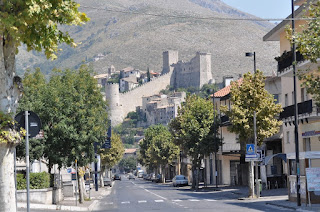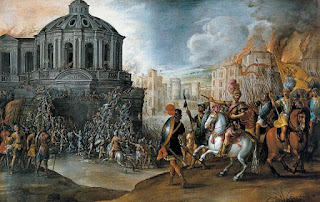Brief life of a Cardinal, soldier and patron of the arts
 |
| Ippolito de' Medici, as portrayed by Titian between 1532 and 1534, in Hungarian dress |
Ippolito de' Medici, who ruled Florence on behalf of his
cousin, Giulio, after he became Pope Clement VII, died on this day in 1535 in
Itri in Lazio.
At the age of 24, Ippolito was said to have contracted a
fever that turned into malaria, but at the time there were also rumours that he
had been poisoned.
There were two possible suspects. The fatal dose could have
been administered on behalf of Alessandro de' Medici, whose abuses he was just
about to denounce, or on behalf of the new pope, Paul III, who was believed to
want Ippolito’s lucrative benefices for his nephews.
Ippolito was born in 1509 in Urbino, the illegitimate son of
Giuliano de' Medici. His father died when Ippolito was seven and he came under
the protection of his uncle, Pope Leo X. When he died five years later,
Ippolito’s cousin, Giulio, who had become Pope Clement VII, sent him to
Florence to become a member of the government, destined to rule the city when
he was old enough.
Ippolito ruled Florence on his behalf between 1524 and 1527
but then Clement VII chose his illegitimate nephew, Alessandro, to take charge
of Florence instead.
He created Ippolito a Cardinal in 1529 and named him
archbishop of Avignon, which gave him a considerable income. Although there is
no evidence that he was ever ordained as a priest or consecrated as a bishop,
Ippolito was named Cardinal Priest of Santa Prassede and then Papal Legate in
Perugia.
 |
| The ancient castle at Itri in Lazio, where Ippolito died |
But Ippolito wanted to be the ruler of Florence rather than
a cleric and was to spend the rest of his short life trying to depose his
cousin, Alessandro.
In August 1529 Ippolito was one of the three Cardinals who
met Emperor Charles V in Genoa to conduct him in state to Bologna for his
coronation as Emperor.
In 1530 Clement VII granted Ippolito a half share of the
annual papal income from the town and territory of Clusium for his lifetime.
Ippolito was sent to Hungary as Papal Legate in 1532 where
he led 8,000 soldiers against the Ottoman Turks.
That same year he was named vice chancellor of the Holy
Roman Church, the most lucrative office in the church, and he was transferred
to the church of San Lorenzo in Damaso.
 |
| Jacopo Pontormo's portrait of Alessandro |
After Ippolito’s cousin, Clement VII, died, Cardinal
Alessandro Farnese was elected Pope and took the name of Paul III.
Ippolito acted as Florentine ambassador to Emperor Charles
V, passing on to him complaints about the administration of Alessandro de' Medici.
When he became ill with a fever and subsequently died on 10
August 1535 he was on his way to north Africa to present his case against
Alessandro to the Emperor, who was on a military campaign there. It was
rumoured he had either been poisoned by Alessandro de' Medici to prevent him
from denouncing him, or by the new pope, Paul III, who wanted his posts in the
church for his own nephews.
Ippolito had been a generous patron of the arts, which was
acknowledged by Giorgio Vasari in his writing, and he was painted by Titian
wearing Hungarian costume in 1533.
He was unsuitable for the church because of his friendship
with a Venetian courtesan and his love for Guilia Gonzaga, who was painted by
artist Sebastiano del Piombo, who also enjoyed Ippolito’s patronage.
But Ippolito enjoyed the lavish lifestyle his position in
the church gave him. Clement VII had reputedly once tried to sack members of
his household, which Ippolito had resisted on the grounds that although he
probably did not need them, they needed him.
 |
| The Church of San Michele Arcangelo in Itri |
Travel tip:
Itri in Lazio, where Ippolito died en route to Africa, is a
small town in the province of Latina. It lies in a valley between the mountains
and the sea near the Gulf of Gaeta. It has an ancient castle in the upper part
of the town and the local people speak Itrano, a variation of the Naples
dialect. The film Two Women, starring Sofia Loren, was filmed in Itri.
Travel tip:
Urbino, where Ippolito was born, is a beautiful city on a
steep hill inland from Pesaro in the Marche region. The Ducal Palace, made
famous by Castiglione’s The Book of the Courtier, is one of the most important
monuments in Italy and is listed as a Unesco World Heritage site.









